Summary
Looking at the G10 currencies in June shows that the dollar weakened, but that the yen softened even further. We think this yen weakness was due to a decline in real interest rates driven by the disparity between monetary policy in Japan and overseas and the BOJ's continued monetary easing. The USD/JPY reached 145 on 30 June. We had expected this to be a ceiling but in the short term we think a response from the Japanese authorities is the only thing that can curb the yen's slide. We expect the BOJ to end YCC at its monetary policy meeting at the end of July given the growing risk that yen depreciation will boost inflation, but that meeting is still some time off. Japanese authorities are on guard, but we expect a strong move past USD/JPY 145 would bring 150 into view.
June in review
The USD/JPY opened the month at 139.14. It briefly reached the 140 level at the end of May and continued to trade between around 138.5 to 140.5 early in June amid expectations that the Japanese authorities would move to curb yen weakness, such as through a three-party meeting between the Ministry of Finance, the Financial Services Agency, and the BOJ. The FOMC meeting on 14 June kept policy rates on hold as the market had expected, but the dot plot revealed a hawkish shift indicating the possibility of two more rate hikes in 2023. This resulted in a rise in UST yields, primarily at the belly, and the USD/JPY broke out of its range and rose above 141. The BOJ left policy unchanged at its monetary policy meeting on 16 June and Governor Kazuo Ueda's subsequent press conference was also seen as dovish. The market had not expected any policy changes, but the yen weakened due to the disparity between monetary policy in Japan and overseas. The USD/JPY approached 142 on the same day in overseas trading hours. The pair looked top heavy after reaching 142 on Monday 19 June but rose again after Fed Chair Jerome Powell said he thought two more rate hikes within the year would be appropriate in his testimony to Congress on 22 June. The USD/JPY swept past the 142.5 level, which had been seen as a chart point, and rose to 143. It approached 144 on 23 June, prompting Vice Finance Minister for International Affairs Masato Kanda to move to rein in the yen's decline on the morning of Monday 26 June (Japan time). Finance Minister Shunichi Suzuki and Chief Cabinet Secretary Hirokazu Matsuno also issued warnings, which worked to curb the rise in the USD/JPY on fears that the government would intervene in the currency markets. However, the USD/JPY continued to climb intermittently after that due to the announcement of strong US economic data toward the end of June and a renewed focus on the disparity between monetary policy in Japan and overseas at the ECB forum on central banking. In the morning session on 30 June, the USD/JPY rose to the 145 level for the first time since 10 November 2022. It was trading above 144.5 at the time of writing this report (Figure 1).
From dollar weakness in May to yen weakness
The yen was weak in June. The dollar weakened overall among G10 currencies, but the yen fell more than 3% against the dollar (Figure 2). The USD/JPY traded in a range for some time after reaching 140 at the end of May, then started on a steady uptrend from 16 June. The disparity between the monetary policy stance of the BOJ and other central banks came into view again following the BOJ's monetary policy meeting on 16 June. The BOJ's insistence on maintaining extraordinary easing measures has created a sense of security for yen selling.
In this regard, Governor Ueda spoke about yen weakness at the ECB forum on central banking on 28 June, saying in front of both Chair Powell and ECB President Christine Lagarde, that the yen was influenced by many factors other than the BOJ's monetary policy, including the policies of other central banks. The atmosphere at the forum was friendly enough, but Ueda's remarks could be interpreted as an acknowledgment that the disparity in monetary policy between Japan and overseas is behind the yen's weakness. In addition, continued easing by the BOJ will at the least make it difficult to buy the yen.
In addition, the BOJ's stance is pushing down the yen's real interest rate, which has also been accelerating yen weakness. The disparity in nominal interest rates, which has been in focus since last year, may be inadequate to explain the USD/JPY's rise to 145, but the decline in real interest rates due to the impact of monetary easing stands out in contrast to rising rates in other countries around the world (Figure 3). We think financial transactions such as currency hedging when overseas investors purchase Japanese yen-denominated assets and carry trade in which the yen is procured at low interest rates and invested in foreign assets are driving the current weakening of the yen.
Naturally, the Japanese authorities are taking an increasingly vigilant stance toward the yen's depreciation. The Ministry of Finance, the Financial Services Agency, and the BOJ held a three-party meeting on 30 May, and even after this the MOF's top currency official Masato Kanda continued to make remarks aimed at checking the yen's depreciation. On 26 June, after the USD/JPY broke past 142, which had been considered a chart point, he strengthened his language, saying that speculative positions are accumulating. In fact, IMM speculative positions show an increase in yen selling (Figure 4). Based on last year's experience, we take Kanda's words as a message that the government is prepared to intervene with yen buying if necessary. Note that in 2022, the Japanese authorities moved to conduct a yen-buying intervention on 22 September, when the USD/JPY was at the 145 level.
FIGURE 1: USD/JPY (DAILY)

Note: As at 13:00 JST on 30 June
Source: EBS, MUFG
FIGURE 2: MAJOR CURRENCIES' RATE OF CHANGE VS USD IN JUNE
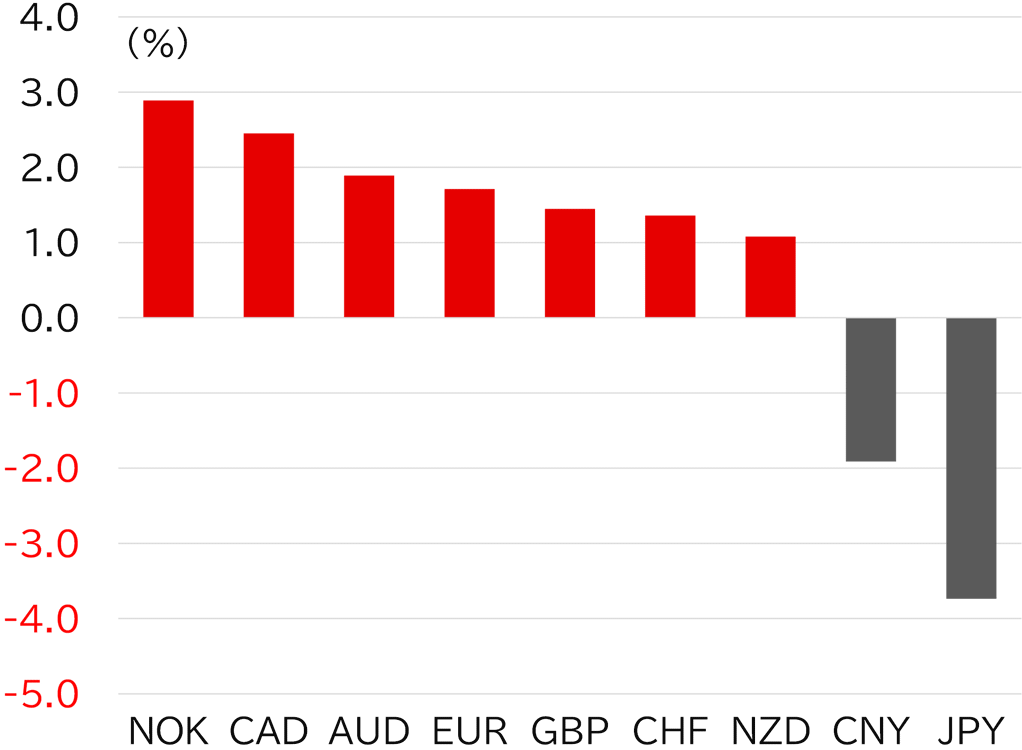
Note: As at 13:00 JST on 30 June
Source: Bloomberg, MUFG
FIGURE 3: YEN REAL INTEREST RATE AND NEER
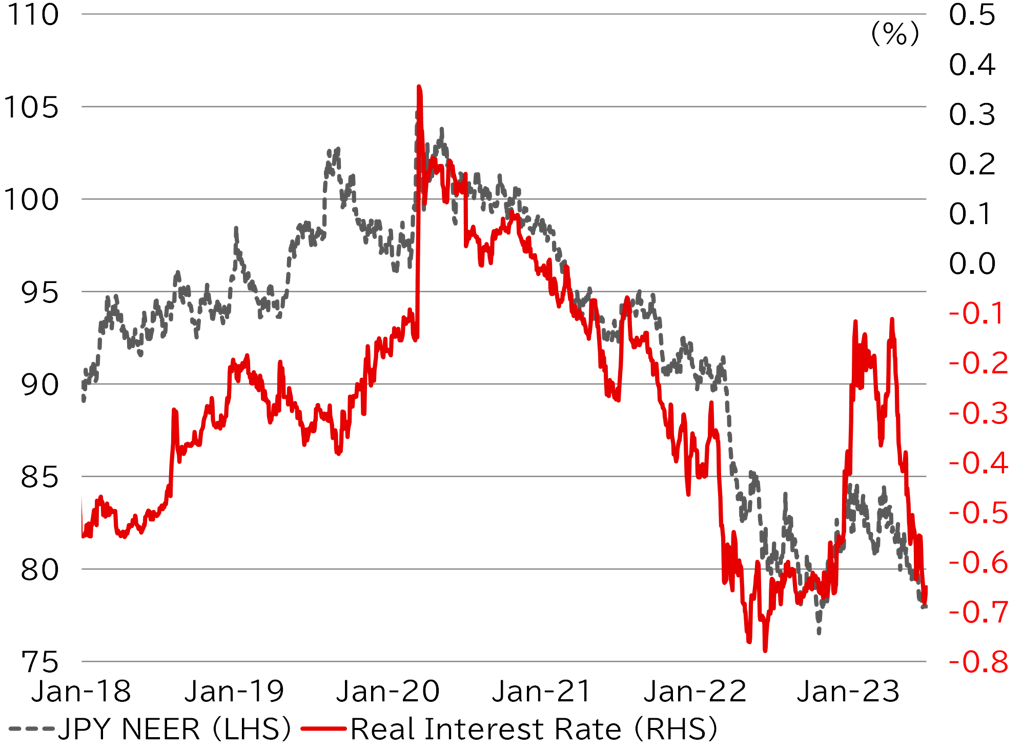
Source: Bank for International Settlements, Bloomberg, MUFG
FIGURE 4: IMM SPECULATIVE YEN POSITIONS AND YEN NEER
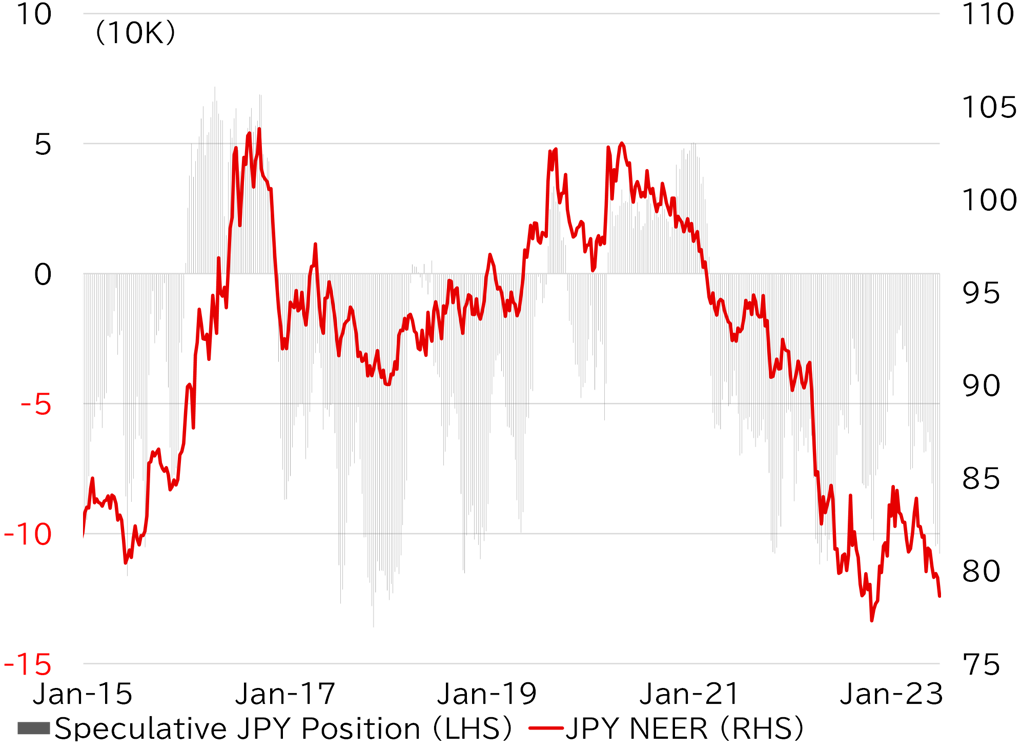
Source: CFTC, Bank for International Settlements, Bloomberg, MUFG
Fed says two more hikes this year
The FOMC held off on raising rates in June. However, in the quarterly Summary of Economic Projections, the dot plot showed higher expectations for the federal funds rate. The median fed funds rate forecast at the end of 2023 was 5.625%, indicating that there will be two more hikes from this point (Figure 5). This was more hawkish than had been expected. We cannot say with certainty that there will be two more hikes this year, but three months ago, we had considered the current upper limit of 5.25% as the terminal rate for the current phase of interest rate increases, so we (and the financial markets) were forced to revise our view, including pushing back the outlook for the timing of subsequent interest rate cuts. Powell also did not rule out the possibility of consecutive interest rate hikes at the ECB forum on 28 June. The market is now moving to factor in two more hikes by the end of the year, which has encouraged the dollar to strengthen somewhat. As a result, concerns about the widening disparity between monetary policy in Japan and overseas is likely to put upward pressure on the USD/JPY.
However, looking at the overall foreign exchange market in June, it is worth noting that the dollar was weak relative to major currencies. The dollar has not shifted to full-fledged strengthening despite central banks becoming increasingly hawkish and the dot plot showing a higher forecast for rates because this has not changed the outlook for a 100bp rate cut in 2024. We think this is why the USD/JPY is still near last year's high, while cross-yen rates are hitting record lows for some currencies.
The US economy remains solid, and inflation has not slowed at the pace the market expected (Figure 6). The Fed also upgraded its inflation outlook in the summary of economic projections. We therefore expect the Fed to maintain its hawkish stance in the near term. Of course, opinions may be divided among senior Fed officials as the final phase of the rate hike cycle approaches, but it will probably take some time for a consensus to form regarding ending rate hikes or considering rate cuts. We therefore expect the dollar to remain strong for now. However, the dot plot suggests the Fed could halt rate hikes and consider rate cuts by the end of the year. This would result in an end to dollar buying or the start of a phase of dollar selling. Over the medium term, we therefore maintain our forecast that the dollar will weaken, and the USD/JPY will decline (aside from cross-yen rates).
FIGURE 5: FOMC PARTICIPANTS' MEDIAN FED FUNDS RATE OUTLOOK

Source: Fed, MUFG
FIGURE 6: US REAL GDP GROWTH RATE

Source: US Department of Commerce, MUFG
The BOJ's communication assumes continued monetary easing, reassuring yen sellers
The BOJ kept its policy on hold at the second monetary policy meeting headed by Governor Ueda. Expectations for a change in policy were not particularly high this time, but the yen weakened after the announcement of the Bank's statement and the governor's press conference. At his press conference, Ueda said that the above 3% YoY growth in headline inflation and core CPI excluding fresh foods was well above the Bank's target and has become a considerable burden on citizens. However, he attributed this to cost-push inflation from overseas, which cannot be directly controlled by the BOJ's monetary policy. He maintained his view that inflation will decline in 2H FY23 because import prices had already shifted to lower inflation. He also reiterated his stance that it is appropriate to continue with monetary easing given the uncertain outlook for prices and a lack of confidence in achieving the price stability target. Taking these statements at face value suggests that the BOJ will maintain monetary policy for some time until it is confident of achieving the price stability target. We think a change in monetary policy is still some time off considering Ueda said that wages would also need to be rising steadily for such a move. However, Ueda himself has repeatedly said that the characteristics of the YCC policy mean that a revision or abolition of YCC will inevitably come as a surprise. In other words, since the BOJ decided to maintain policy settings at its most recent meeting, it will have to continue communications based on the assumption that the policy will be continued at least until the next meeting and will not even be able to hint at any change. We will need to take this well into account when observing communication from the Bank.
The summary of opinions from the June meeting noted "While price rises in Japan are still largely attributable to overseas factors, the contribution of domestic factors has increased, as seen in the fact that consumer prices of services have risen at a notable pace and the YoY rate of change in the GDP deflator has reached 2%." This runs counter to Governor Ueda's view that inflation was primarily caused by overseas factors. It also gave a bullish outlook saying "Corporate behavior has seen clear changes, and price and wage hikes have been incorporated into corporate strategy. In addition, various measures of underlying inflation have mostly shown a rate exceeding 2%. It is highly likely that the year-on-year rate of increase in the CPI (all items less fresh food) will decelerate toward the middle of FY23 but will not fall below 2%." Tokyo CPI for June announced on 30 June showed core (excluding fresh food) CPI growth of 3.2% YoY (Figure 7). This is a slight slowdown from May but means inflation in 1Q FY23 exceeded 3%. The BOJ's April Outlook Report forecast 1.8% inflation in FY23, meaning it may have to soon revise this up (Table 1).
The BOJ will release the next Outlook Report and update its forecasts at the end-July monetary policy meeting. The summary of opinions from the meeting in June suggests that the Bank could revise up its forecasts at the July meeting depending on various indicators announced through to the end of July. In this case, it could see inflation declining in the near term but not falling below 2%. At the ECB forum on 28 June, Governor Ueda said that a reacceleration in inflation next year would present a good reason to shift policy. If the forecasts in the July Outlook Report present such a forecast, we would interpret this as the Bank starting its move to end YCC as a first step toward the normalization of monetary policy.
The summary of opinions noted that with achieving the price stability target becoming more likely "the Bank should maintain the overall framework of monetary easing for the time being, since the cost of waiting for such achievement is not high. That said, as for yield curve control - a policy tool for monetary easing - the cost is high, taking into account such factors as (1) preventing sharp fluctuations in interest rates in the future phase of an exit from the current monetary policy, (2) improvement in market functioning, and (3) enabling smoother dialogue with market participants. Given all of this, a revision to the treatment of yield curve control should be discussed at an early stage." We think this can be viewed as Governor Ueda's opinion since the governor has editorial rights on the summary of opinions. This would suggest the governor thinks the time is right to at least consider a return from extraordinary easing to a more conventional form of easing. At the very least, this logic would allow the stance of maintaining monetary easing. We therefore think it would be somewhat naive to assume the BOJ will do nothing for the time being, including the abolishment of YCC.
The BOJ publishes the Outlook Report quarterly in April, July, October, and January. The timing of a dissolution of parliament and general election, which the government recently put off, could come into view around the time the October report is released. We see the possibility that by next January, the prospect of wage increases in FY24 could become clear to some extent and that inflation could still be elevated. The outlook for inflation becomes increasingly uncertain the more distant the time horizon for the forecast. We therefore think Ueda's remark on 28 June about the possibility of a reacceleration in inflation next year was meant as a message to ease the view that price stability was a condition even further beyond that. In addition, the ongoing depreciation of the yen could also prompt an upward revision of the near-term inflation outlook. The Bank is unlikely to use the weak yen as a reason to change monetary policy, but a further weakening of the yen would be one factor feeding into revisions to the Outlook Report. Considering this point as well, we see a reasonably high possibility that the BOJ will move to change its policy settings in July. The financial markets are skeptical of this view and have not factored it in. However, at a speech to business leaders in Kagoshima, BOJ board member Seiji Adachi noted that there is more than a month until the BOJ's policy meeting in July and many things could happen in that time. We think this suggests the Bank wants to avoid having no option but to maintain the status quo.
FIGURE 7: TOKYO CPI (YOY)
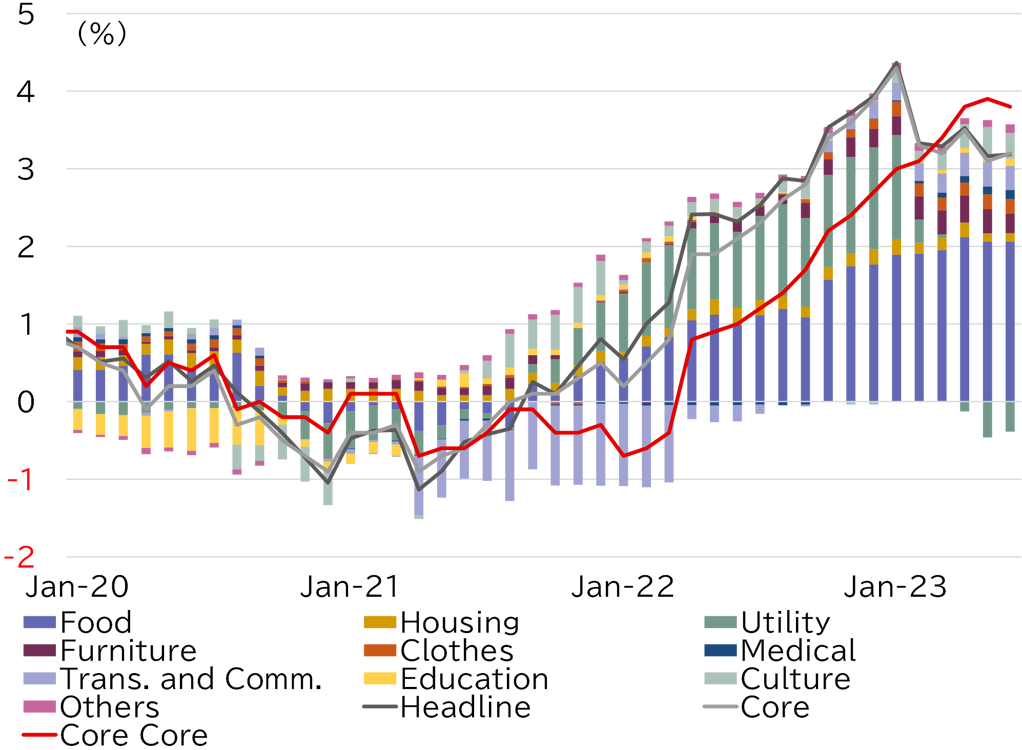
Source: MIC, MUFG
TABLE 1: APRIL OUTLOOK REPORT FORECASTS

Source: BOJ, MUFG
Do not underestimate Japanese authorities' concern about the weak yen
Vice Finance Minister for International Affairs Masato Kanda was quick to say that the recent weakening of the yen has a strong speculative aspect. We think he set a stringent tone in such efforts to rein in the yen's slide, although it lacks the sense of speed that the Japanese authorities have been on guard for. In fact, the "quality" of the yen's depreciation has changed compared to last year. We have little interest in talk of good versus bad yen depreciation, but it is important to note that last year non-speculative yen selling continued unabated before the yen weakened due to speculative selling, while this year non-speculative yen selling has been soft. For example, Japan's trade balance in May was -¥1.4 trillion, with the country still in a trade deficit (Figure 8). However, in May 2022 it was -¥2.4 trillion. In other words, the deficit shrank by ¥1 trillion compared to last year. The main reason for this was a sharp decline in the value of imports due to a fall in the price of mineral fuels such as crude oil, LNG, and coal. Unfortunately, the weaker yen has not led to an increase in exports, but recent trends in energy prices suggest that the trade balance will continue to improve from last year. In addition, due to the recovery of inbound tourism since the end of last year, the travel (service) balance has improved (increased income) by about ¥300bn per month (Figure 9). Non-speculative yen selling is weakening in line with this improvement in the trade balance.
The weakening of the yen despite this suggests that it does have a strong speculative character, as the authorities have pointed out. Looking at this from a different perspective, we could say that the recent weakening of the yen does not have powerful underlying momentum. This means that a certain degree of yen buying is likely to return if the Japanese authorities intervene to buy the yen or the BOJ changes its monetary policy. We see a reasonable prospect of the BOJ revising its policy, but its next board meeting is not until the end of July. The yen has already briefly touched the 145 level, and we see the risk of further weakening through to the end of July. In that case, the Japanese authorities may also escalate their response.
We currently see little sense of crisis in public opinion about the ongoing depreciation of the yen. It is true that the USD/JPY has not yet surpassed last year's high, and the simultaneous rise in stock prices seems to have taken the spotlight off the weakening yen. However, as we have repeatedly said, the tone of the authorities is by no means weak. Rather, there seems to be considerable concern about the weak yen pushing up inflation. After the USD/JPY broke past 145, Finance Minister Shunichi Suzuki said that the weaker yen boosted import prices and was a negative for policy issues such as fast rising prices. One example is the cost of gasoline. The government is gradually reducing its subsidies to mitigate sudden fluctuations in fuel oil prices, which is one of the inflation-relief measures it put in place last year. The subsidies are due to end at the end of September, and gasoline prices are already slowly rising due to a reduction in subsidies. Gasoline prices are expected to rise even if crude oil prices do not increase, and the yen does not weaken. The subsidy will be increased if costs rise sharply, but the program will end in September, meaning that a further weakening of the yen after that could trigger a steep rise in gasoline prices. The public is currently showing little concern about the weakening of the yen, but we emphasize the word "currently." We think it is safe to assume that the authorities view the weak yen with the same sense of urgency as last year. Given their response at that time, we cannot rule out the possibility of yen-buying intervention going forward.
FIGURE 8: TRADE BALANCE

Source: MOF, MUFG
FIGURE 9: TRAVEL BALANCE
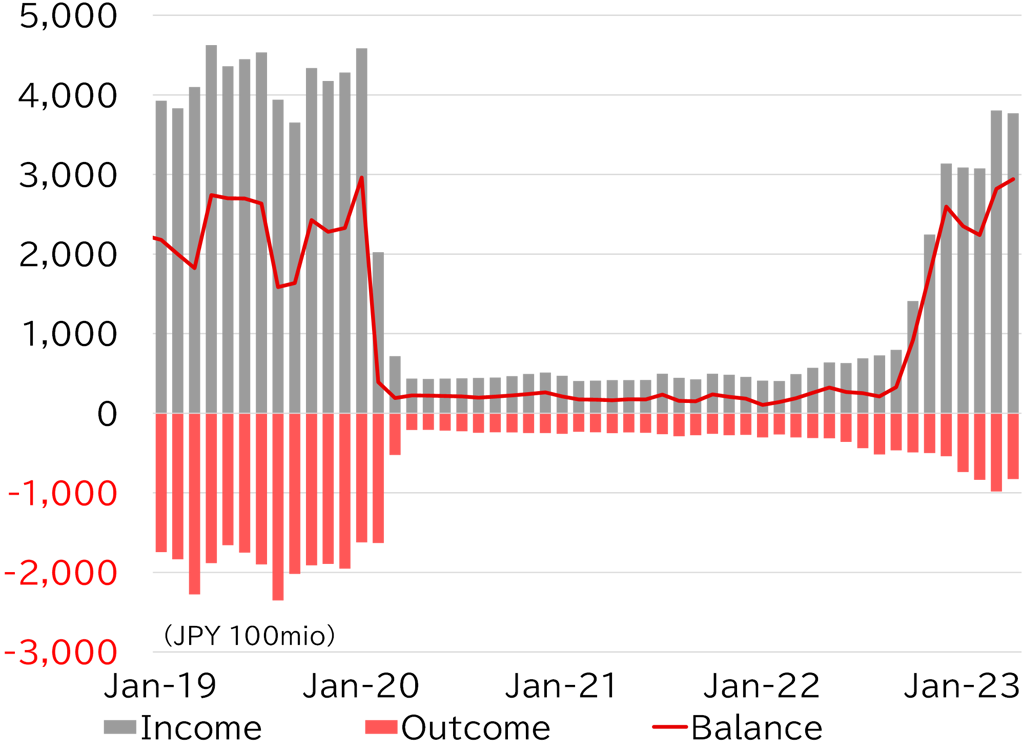
Source: BOJ, MUFG
USD/JPY could be heading for 150 in the short term
We therefore expect the USD/JPY to come under downward pressure from moves by the BOJ and the Japanese authorities in the short term, and by changes in the Fed's monetary policy over the medium term. A policy shift by the BOJ could result in a considerable strengthening of the yen. However, in the immediate term, or if the BOJ does not shift gears at the July monetary policy meeting, we see the risk of the yen weakening further. The decline in the yen real interest rate, which has been driving the recent weakening of the yen, is also approaching its limit. Market proverbs warn of the danger of picking market highs and lows, but based on last year's experience, we expect the USD/JPY to head toward 150 if it breaks past 145 with momentum. We have therefore raised the upper end of our forecast range.
QUARTERLY FORECAST RANGE AND PERIOD-END FORECAST
|
Jul-Sep 2023 |
Oct-Dec |
Jan-Mar 2024 |
Apr-June |
|
|
USD/JPY |
134.0~150.0 |
132.0~148.0 |
130.0~146.0 |
128.0~144.0 |
|
Period-end forecast |
136.0 |
134.0 |
132.0 |
130.0 |
Our forecast range estimates the high and low for each quarter. The period-end forecast is our forecast for USD/JPY at 17:00 New York time at the end of each quarter.
